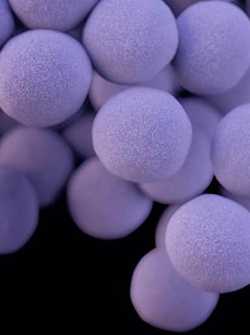Staphylococcal Food Poisoning

Vancomycin-resistant Staphylococcus aureus
What is staphylococcal food poisoning?
Staphylococcal food poisoning is a gastrointestinal illness caused by eating foods contaminated with toxins produced by the bacterium Staphylococcus aureus (Staph). Staph is found on the skin and in the nose of about 25% of healthy people and animals. It usually does not cause illness in healthy people, but Staph has the ability to make toxins that can cause food poisoning.
How do people get staphylococcal food poisoning?
People who carry Staph can contaminate food if they don’t wash their hands before touching it. Staph can also be found in unpasteurized milk and cheese products. Because Staph is salt tolerant, it can grow in salty foods like ham. As it multiplies in food, Staph produces toxins. Although Staph bacteria are easily killed by cooking, the toxins are resistant to heat and so cannot be destroyed by cooking. Foods at highest risk of transmitting Staph toxins are those that people handle and then do not cook. Examples are sliced meat, puddings, pastries, and sandwiches. Food contaminated with Staph toxin may not smell bad or look spoiled.
What are the symptoms of staphylococcal food poisoning?
Staphylococcal toxins are fast-acting, symptoms usually develop within 30 minutes to 6 hours. Patients typically experience vomiting, nausea, stomach cramps, and diarrhea. The illness cannot be passed to other people and typically lasts for only 1 day. Severe illness is rare.
How do I know if I have staphylococcal food poisoning?
Toxin-producing Staph can be identified in stool or vomit using specialized techniques. The toxins can also be detected in foods. Suspicion of staphylococcal food poisoning is generally based only on the signs and symptoms of the patient. Testing for the toxin-producing bacteria or the toxin is not usually done in individual patients, but can be done for outbreaks. If you think you may have food poisoning, contact your doctor.
How is staphylococcal food poisoning treated?
For most patients, staphylococcal food poisoning is a brief illness. The most important treatment is plenty of fluids. Medicines may be given to decrease vomiting and nausea. Patients with severe illness may require intravenous fluids in a hospital.
Antibiotics are not useful in treating this illness because the toxin is not affected by antibiotics.
Are sick patients contagious?
Patients with this illness are not contagious because the toxins are not transmitted from one person to another.
How can staphylococcal food poisoning be prevented?
Staphylococcal food poisoning can be prevented by preventing the contamination of food with Staph. The following food safety tips can help protect you and your family:
- Wash hands and under fingernails thoroughly with soap and water before handling and preparing food.
- Do not prepare food if you are ill.
- If you have wounds or infections on your hands or wrists, wear gloves while preparing food.
- Keep kitchens and food serving areas clean.
- If food is to be stored longer than two hours, keep hot foods hot (warmer than 140°F) and cold foods cold (40°F or colder).
- Store cooked food in a wide, shallow container and refrigerate as soon as possible.
Could staphylococcal toxins be used in a bioterrorist attack?
Staph toxins could be used as a biological agent either by contamination of food or water or by aerosolization (using pressure to produce a fine mist) and inhalation. Breathing in low doses of staphylococcal enterotoxin B may cause fever, cough, difficulty breathing, headache, and some vomiting and nausea. High doses of the toxin have a much more serious effect.
Looking for information on staph infections?
- Page last reviewed: September 19, 2016
- Page last updated: October 4, 2016
- Content source:


 ShareCompartir
ShareCompartir